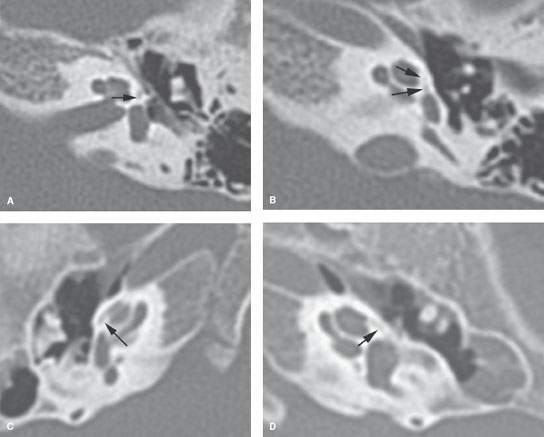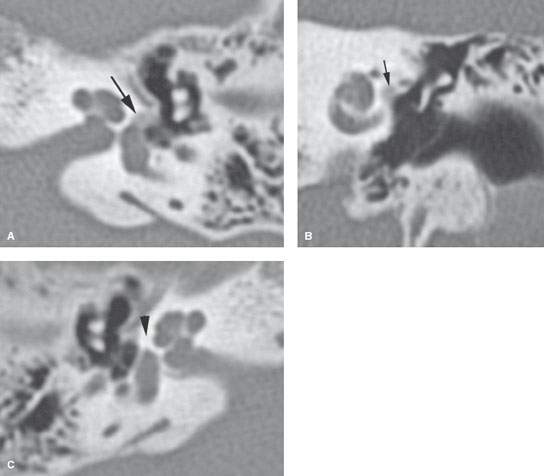OTOSCLEROSIS
KEY POINTS
- Non–contrast-enhanced computed tomography is an excellent means to confirm the clinical diagnosis of otosclerosis.
- No imaging study can exclude otosclerosis.
INTRODUCTION
Etiology
Otosclerosis is a disease that is unique to the otic capsule of humans. The cause is believed to be largely genetic with an autosomal dominant pattern of inheritance, although there is great variability in penetrance and expression of symptomatic disease. As much as 10% of the white population may have the genetic predisposition, but only 1% of those with it will express disease clinically. Many of the asymptomatic population likely have foci of the disease that would be revealed by histologic study of the temporal bone. It is possible that the genetic errors are a predisposing factor to a triggering insult such as the measles virus.
Presentation may vary, with the disease limited to the oval window in its fenestral form; in its cochlear form, it may involve the entire otic capsule. Both forms may begin at the fissula ante fenestram and tend to spread to adjacent areas to a variable degree. The anatomic relationship of the fissula ante fenestram is an interesting although currently incompletely understood link, as foci of disease may be found anywhere in the otic capsule.
Prevalence and Epidemiology
The disease is seen mainly in the white population; it is distinctly uncommon in blacks and exceptional in the Asian population. Phenotypic appearance may not match a given individual’s genotype. It tends to present in young adults, mainly those in the 20- to 35-year age range, but initial manifestations may be much later. It tends to be bilateral but is frequently more symptomatic on one side. Juvenile onset is rare but occurs in those under 10 years of age.
Clinical Presentation
Patients will generally present with progressive conductive or mixed hearing loss. Rarely will sensorineural hearing loss predominate. The hearing loss may have precipitated during pregnancy. Tinnitus or dizziness may accompany the hearing loss. It may present as pulse synchronous with a reddish retrotympanic mass versus nonpulsatile tinnitus (Fig. 109.2). This discoloration of the promontory is pathognomonic for otosclerosis and is called the Schwartze sign. Audiometry will often suggest this as a primary working diagnosis due to the low frequency loss, especially when no other cause of a conductive loss is apparent from the history, physical examination, audiometry, and other tests of the conductive pathway. Once complete stapes fixation has occurred, there will often be pseudosensorineural hearing loss at the same frequencies due to loss of the inertial component of bone conduction. In that case, the audiogram will show a typical butterfly shape (Carhart notch). After stapes surgery, this sensorineural component may disappear. In the cochlear form of the disease, persistent sensory hearing loss is found and may result in profound deafness. The stapedial reflex is usually absent when conductive hearing loss is found. Intact reflexes discovered in conjunction with conductive or mixed hearing loss suggests the possibility of semicircular canal dehiscence.
Pathophysiology
Anatomy
A detailed knowledge of all middle and inner ear anatomy is necessary to properly assess the presence, extent, and possible complications of treatment for otosclerosis. In particular, the following anatomic structures and their normal variation must be thoroughly familiar to those interpreting images when otosclerosis is in question:
- Oval window niche and stapes foot plate
- Round window
- Fissula ante fenestram as it is seen in all age groups (Fig. 104.30).
- Otic capsule
- Facial nerve
This anatomy is presented in detail in Figures 104.11 through 104.13 and Chapter 104.
Pathology and Patterns of Disease
The otic capsule is normally inert with minimal bone turnover. Otosclerosis increases bone turnover. In the oval window, this may spread across the annular ligament to immobilize the stapes. Extension over the inner ear is accompanied by collateral damage to the membranous labyrinth, manifesting as sensorineural hearing loss, tinnitus, and vertigo.
The disease most frequently begins in the region of the fissula ante fenestram as a focus of osteolysis. This may be associated with productive bony changes usually extending from the region of the fissula ante fenestram to the anterior and superior margin of the oval window, eventually enveloping the round window. Sometimes, there is a dominant osteolytic phase that can involve the entire otic capsule. Pathologically, it affects the endosteal bone at the margin of the labyrinth in a pattern very similar to that seen in Paget disease. The repair bone that follows the osteolysis is laid down in a degraded bony endosteal matrix, in a manner also similar to that seen in Paget disease, resulting in the altered bone density and intensity appreciated on computed tomography (CT) and magnetic resonance imaging (MRI), respectively. This process is accompanied by increased vascularity.
The disease may also occur when there is little or no evidence of an osteolytic phase and be restricted to the margins of the oval window. Otosclerosis is rarely found only at the round window.
An offending infectious agent may enter the otic capsule along the fissula ante fenestram to incite this cycle of bony change, but this is not proven. It is believed that substances released during the progress of the disease, as well as damage to the striae vascularis, contribute to the tinnitus and sensorineural hearing loss that may accompany the cochlear form of the disease.
Pathologically Altered Function
The patient’s main loss is conductive hearing. A sensorineural loss may develop as well. Tinnitus is related to cochlear dysfunction. It may cause pulse synchronous tinnitus due to hypervascularity that may develop during an intense osteolytic phase of the disease.
IMAGING TECHNIQUES
Techniques and Relevant Aspects
Specific protocols for MRI and CT studies for investigating inner ear problems in general appear in Appendixes A and B. Any such magnetic resonance (MR) study must include provision for a three-dimensional steady state acquisition with nominal section thickness ≤1 mm that can be analyzed in any plane. The same type of CT data analysis is necessary.
The inner ear and middle ear are typically studied with non–contrast-enhanced computed tomography (NCCT) studies of the temporal bone for suspected otosclerosis and in almost all cases of conductive or mixed hearing loss in general. MRI studies might be done initially when there is a dominant sensorineural component. MRI must always include images that are as definitive as possible for evaluating the membranous labyrinth of the inner ear and related structures, such as the oval and round windows and fissula ante fenestram region, since it may occasionally suggest a diagnosis of otosclerosis.
Pros and Cons
CT is done first since it most confidently confirms or excludes the diagnosis. Subtle fenestral otosclerosis may go undetected even on the best possible CT examination. CT can also exclude conditions of the middle or inner ear that might mimic otosclerosis such as developmental abnormalities that might cause stapes foot plate fixation, the effects of middle ear disease that may have produced ossicular dysfunction such as osteonecrosis of the incus long process, and superior semicircular canal dehiscence.
MRI may be done to exclude causative pathology of the labyrinth as well as all segments (i.e., brain stem, cisternal, exit canal/foramen, and extracranial segments) of the cochleovestibular nerve (Figs. 104.52 and 104.55 and Chapters 133–135) from its brain stem nucleus to the cochlea and vestibule. It should not be done if otosclerosis particularly manifesting as conductive hearing loss is the primary working diagnosis.
Controversies
Fluoride has been found to be of value in treatment of otosclerosis. Fluoride ions replace the hydroxyl group in hydroxyapatite to form a fluorapatite complex that is resistant to osteoclastic degradation. Oral intake has been shown to stabilize hearing loss—both conductive and sensorineural. Who should receive treatment remains controversial.
There is also some controversy with regard to the role of the fissula ante fenestram and the role of measles virus in its etiology in this development. Also, hormonal factors may have a role in the development of otosclerosis; during pregnancy, accelerated progression of disease is seen, possibly due to release of high levels of estrogen. There is some debate about whether the high-frequency sensorineural loss is coincidental or part of the disease.
There are no controversies related to imaging.

FIGURE 118.1. Normal, prominent fissula ante fenestram (arrows in A and B) in a 30 year old on a study done for nontemporal bone trauma and in a 3 year old (arrows in C and D). The appearance is generally symmetric in a given patient when these are seen as normal variants between the tensor tympani muscle attachment and the oval window. This is shown microscopically in Figure 104.29.
MANIFESTATIONS OF DISEASE
Osteolytic and Osteosclerotic Bone Changes and Contrast Enhancement
Computed Tomography
Not all patients with the clinical diagnosis of otosclerosis are referred to imaging. Imaging is done only if there is a doubt about the clinical diagnosis and in cases of fluctuating hearing loss.
The disease most frequently begins in the region of the fissula ante fenestram as a focus of often subtle osteolysis that might track along the fissula ante fenestram (Figs. 118.1 and 118.2). This must be distinguished from the normal fissula ante fenestram or cochlear cleft that can be quite prominent in children and remain visible up to about 40 years of age (Fig. 118.1). This may be associated with productive bony changes usually extending from the region of the fissula ante fenestram to the anterior and superior margin of the oval window and eventually enveloping the entire oval window and extending down to the round window (Fig. 118.3). This can lead to obstruction of the basal turn, but the new bone formation is usually limited to the proximal part of the scala tympani.1
Sometimes, there is a dominant osteolytic phase that can involve the entire otic capsule; this tends to effect the cochlea more than the vestibule (Fig. 118.4). The repair bone that follows the osteolysis is laid down in a degraded enchondral bony matrix, resulting in the altered abnormal bone density seen within the otic capsule and around the oval and round windows (Fig. 118.5).
The disease may also be seen with little or no evidence of an osteolytic phase and be restricted to the margins of the oval window. These bony changes rarely are found exclusively at the round window (Fig. 118.6).

FIGURE 118.2. Early changes of otosclerosis. On the left, there is a focus of demineralization at the fissula ante fenestram due to relatively early otosclerosis (A, B) compared to the normal right side (C). The disease usually is bilateral and may not be grossly manifest. Negative imaging does not exclude the diagnosis but does make it much less likely.
Stay updated, free articles. Join our Telegram channel

Full access? Get Clinical Tree








